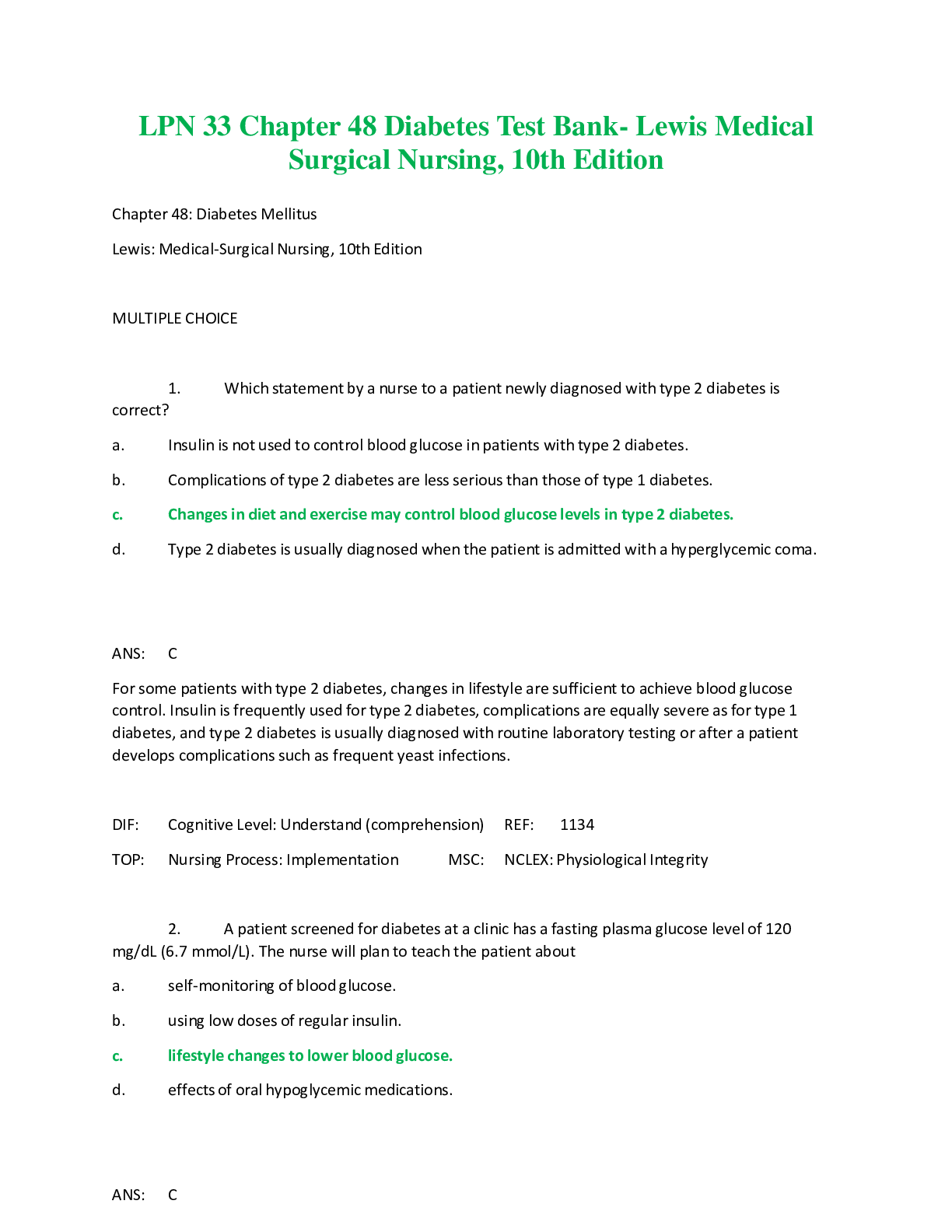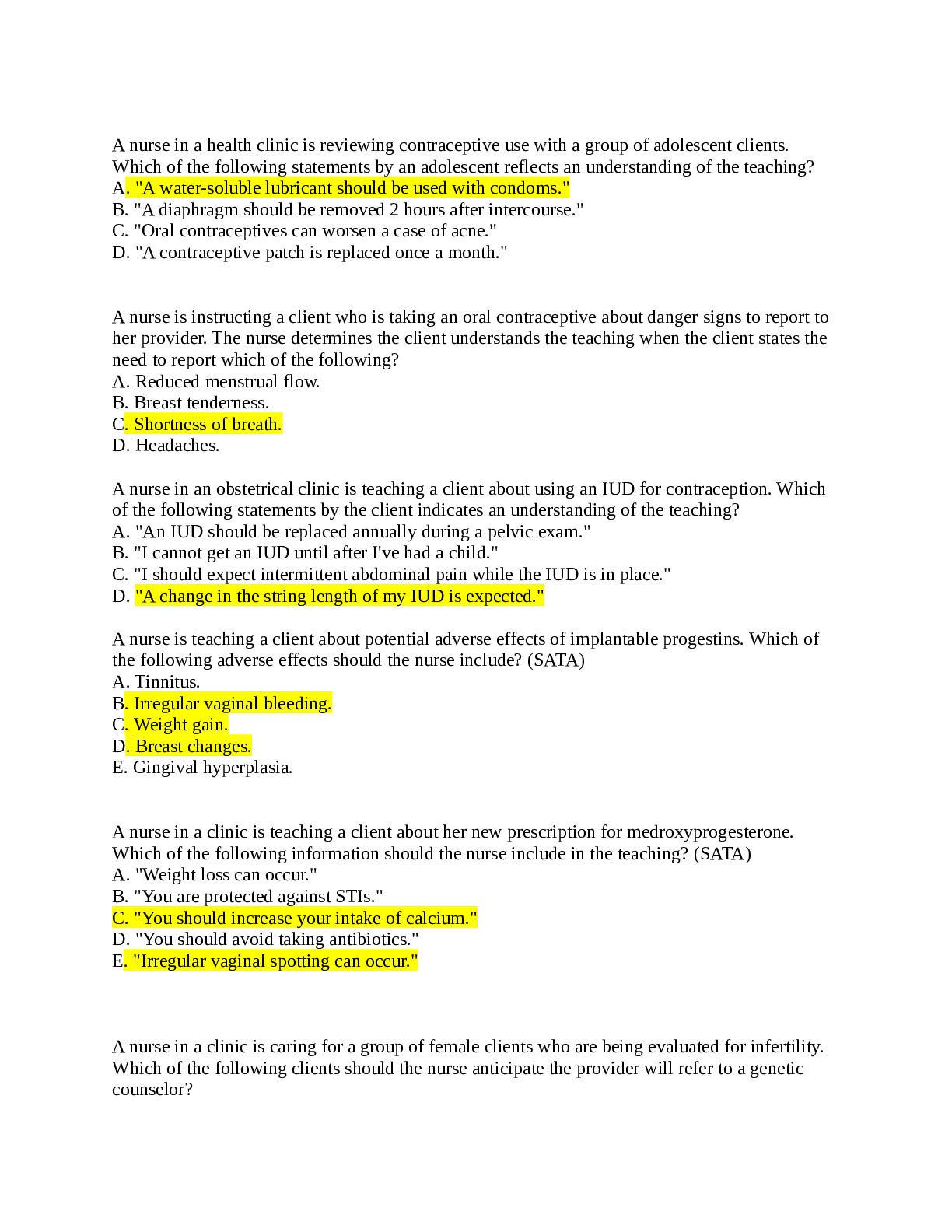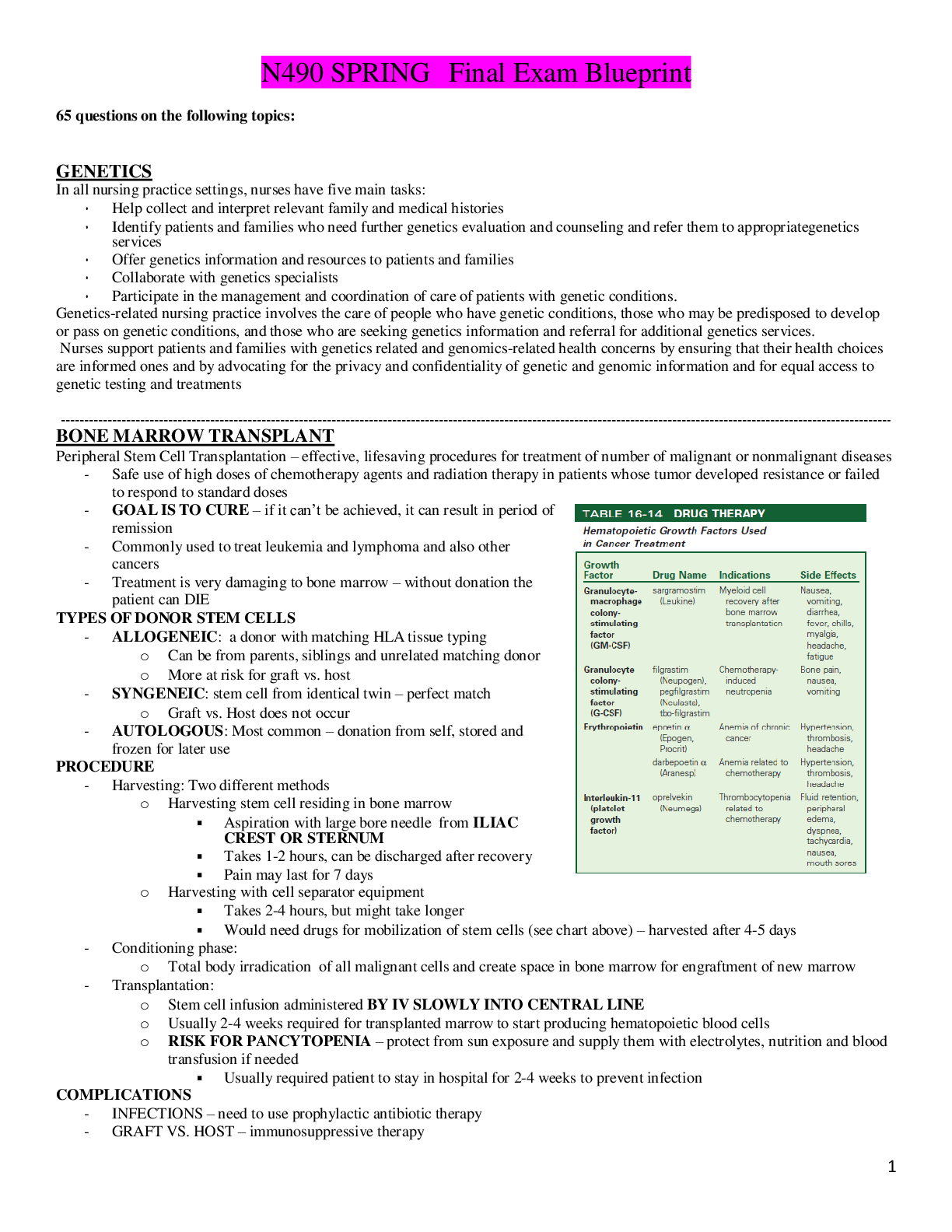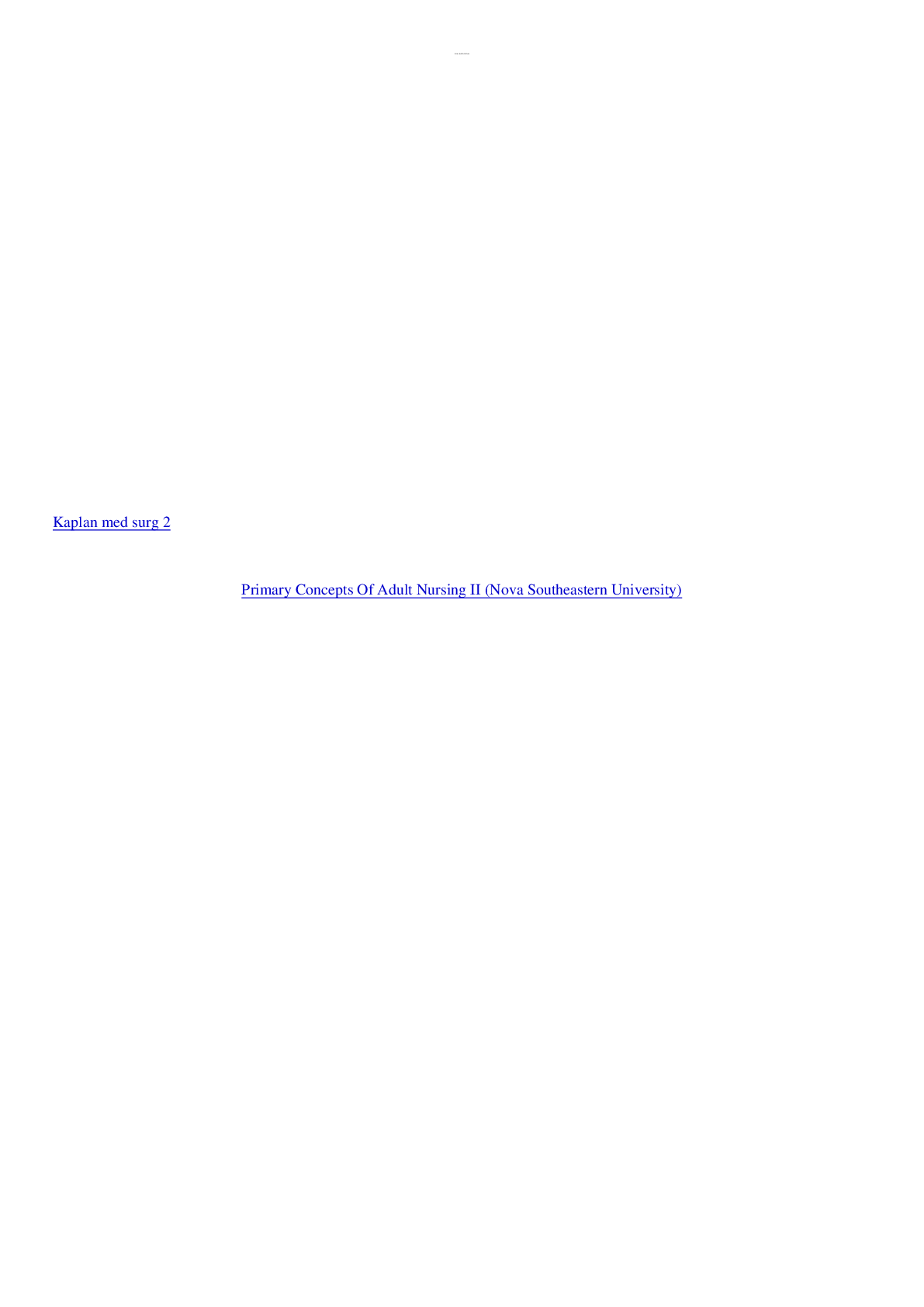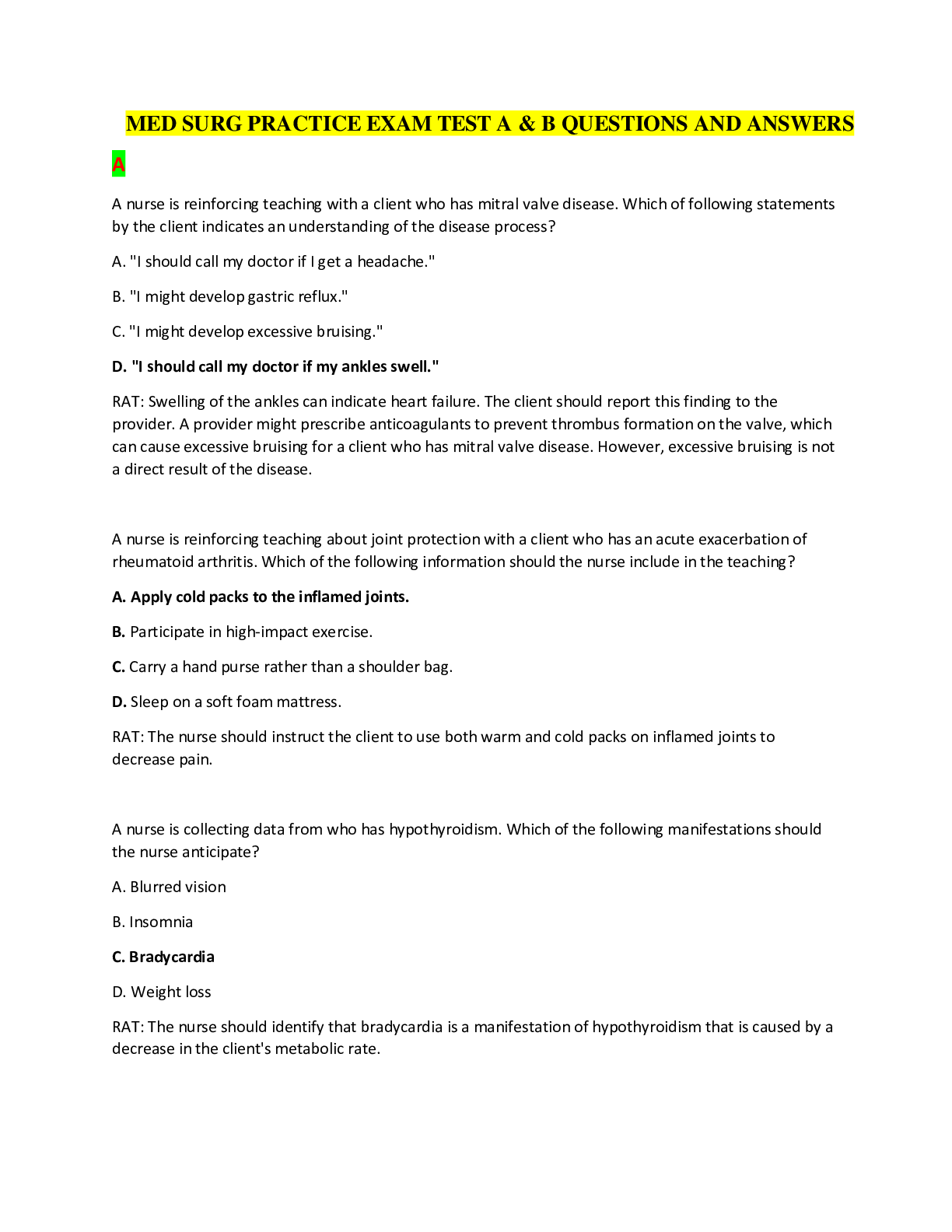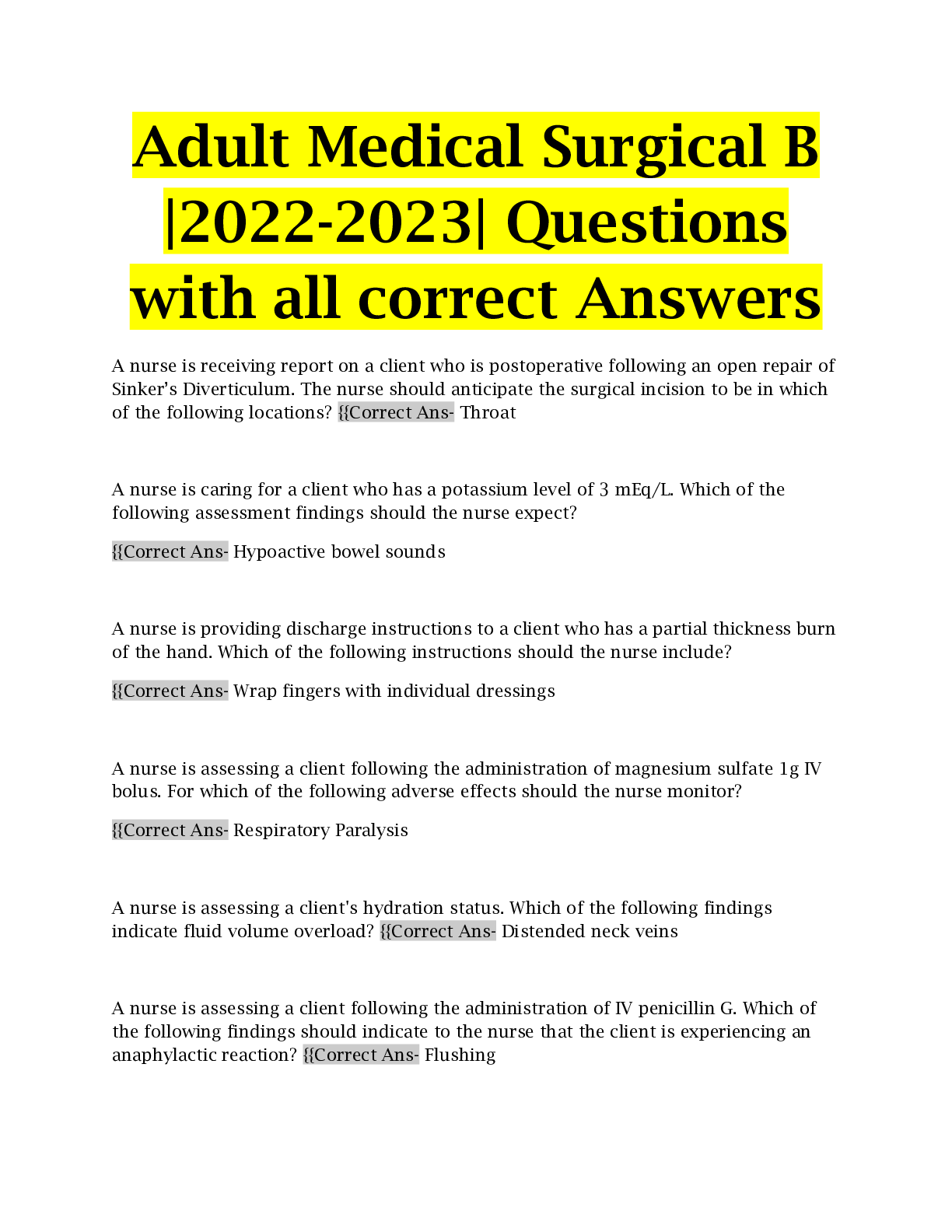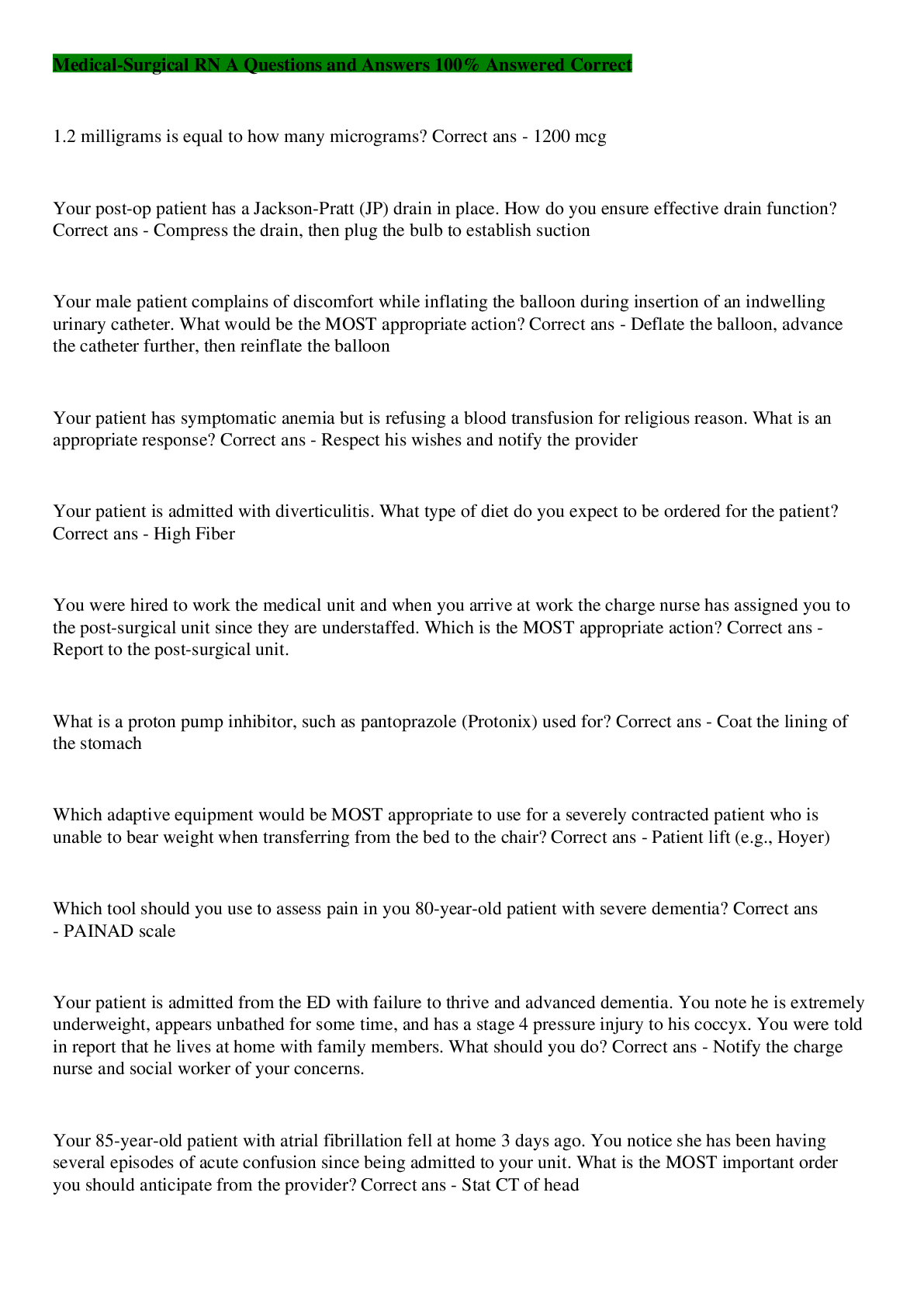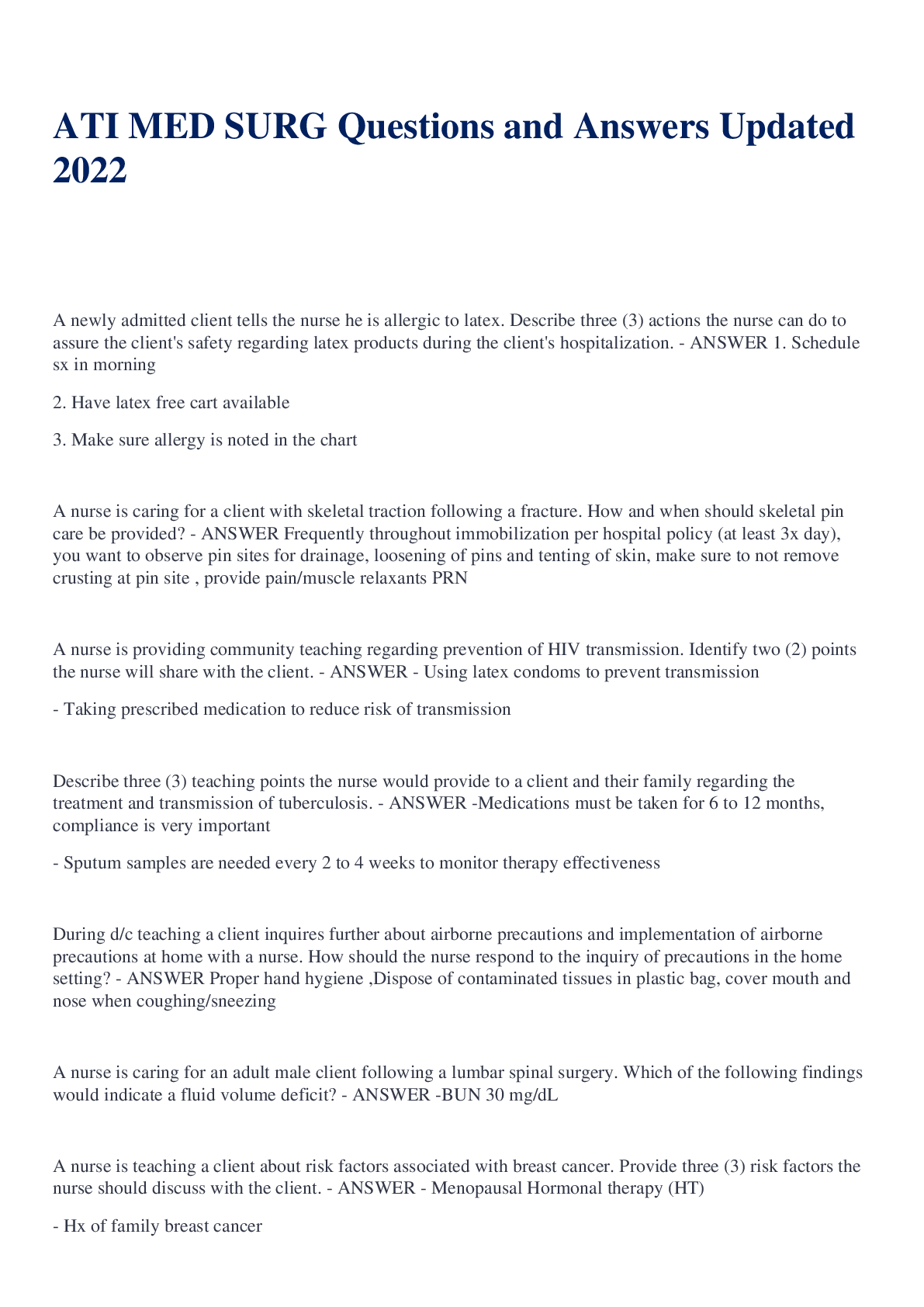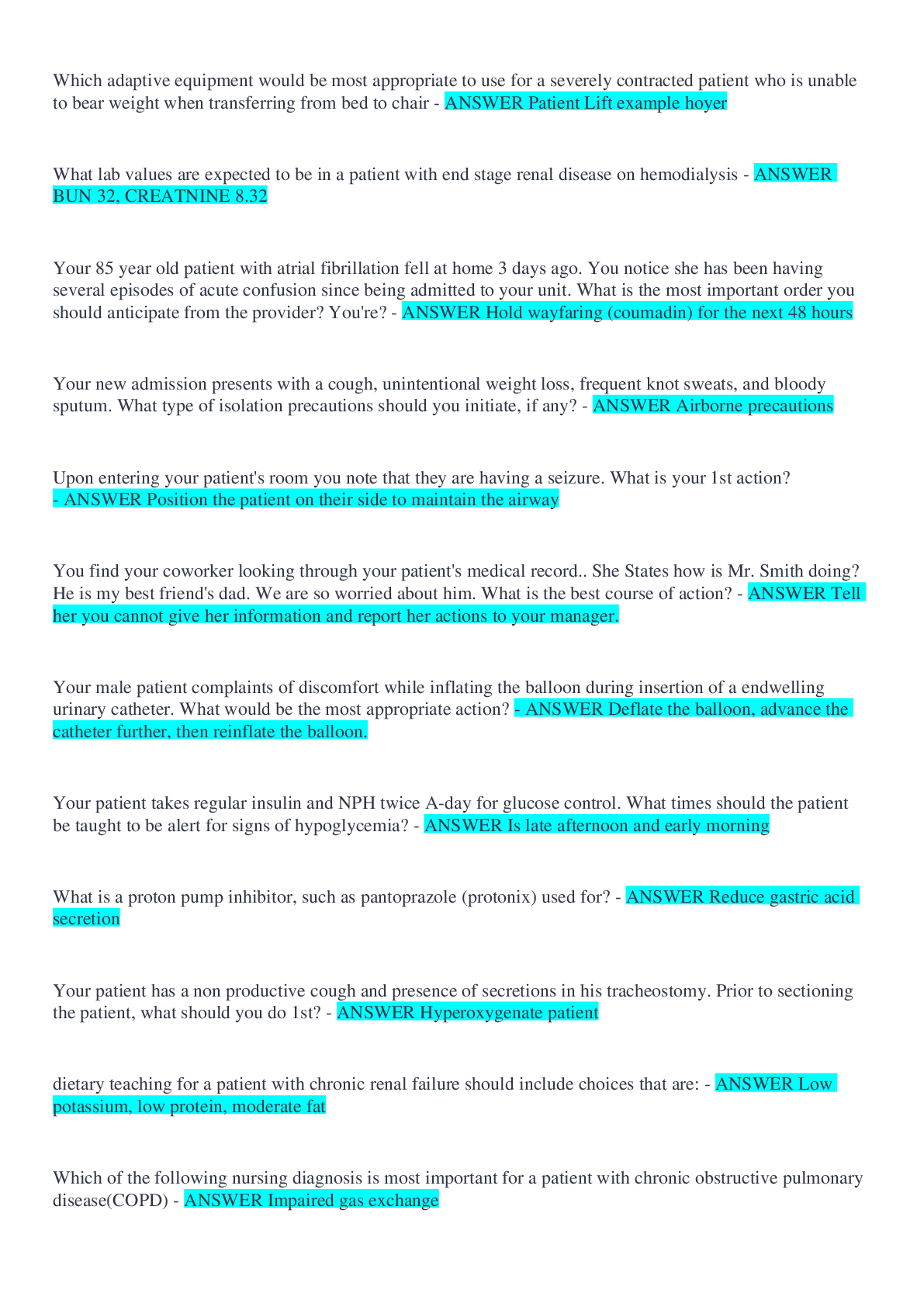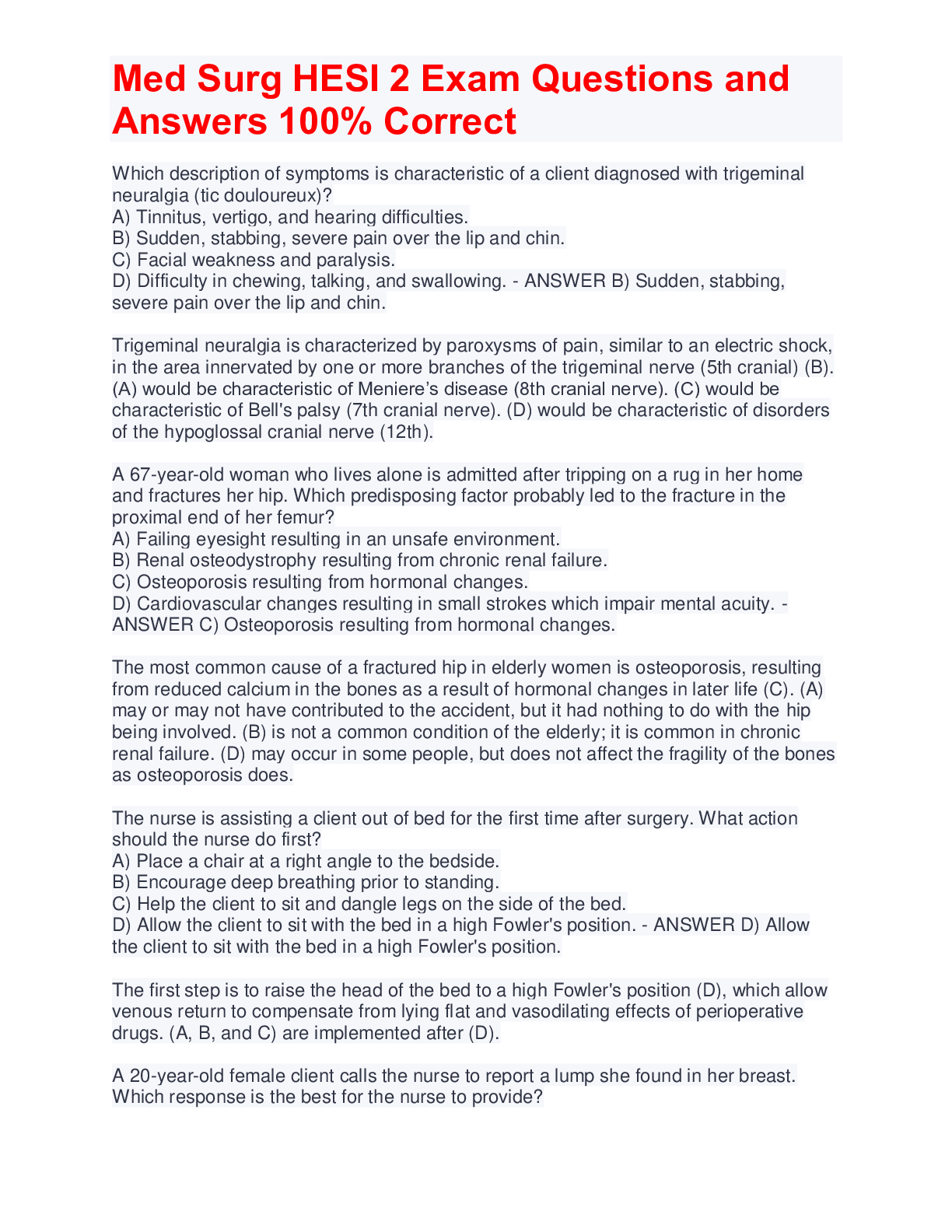*NURSING > MED-SURG EXAM > NURSING Med Surg 2 / ATI Cardio / Questions and Answers with Rationales / 100% Guaranteed Pass (All)
NURSING Med Surg 2 / ATI Cardio / Questions and Answers with Rationales / 100% Guaranteed Pass
Document Content and Description Below
NURSING Med Surg 2 / ATI Cardio / Questions and Answers with Rationales A nurse is caring for a client who has dilated cardiomyopathy. The client reports increasing difficulty completing her dail... y 1-mile walks. The nurse should recognize that this is a finding of which of the following? a. Left ventricular failure b. Peripheral vasodilation c. Pericardial effusion d. Decreased vascular volume a. Activity intolerance is a finding of left ventricular failure and is associated with dilated cardiomyopathy. A nurse is caring for a client who presents to the emergency department with a blood pressure of 254/139 mm Hg. The nurse recognizes that the client is in a hypertensive crisis. Which of the following actions should the nurse take first? a. Obtain blood samples for laboratory testing b. Tell the client to report vision changes c. Place the head of the bed at 45 degrees d. Initiate an IV c. The first action the nurse should take when using the airway, breathing, circulation approach to client care is to place the head of the client’s bed at 45 degrees. This improves respiratory status and promotes venous return to reduce workload on the heart. A nurse is assessing a client who has left-sided heart failure. Which of the following manifestations should the nurse expect to find? a. Increased abdominal girth b. Weak peripheral pulses c. Jugular venous neck distention d. Dependent edema b. Weak peripheral pulses are related to decreased cardiac output resulting from left-sided heart failure. A nurse is caring for a client in the first hour following an aortic aneurysm repair. Which of the following findings can indicate shock and should be reported to the provider? a. Serosanguineous drainage on dressing ATI Cardio b. Severe pain with coughing c. Urine output of 20 mL/hr d. Increase in temperature from 36.8 degrees C (98.2 F) to 37.5 degrees C (99.5 F) c. Urine output less than 30 mL/hr can indicate shock because it reflects decreased blood flow to the kidneys, possibly from graft rupture and hemorrhage. A nurse is caring for a client who has a history of deep-vein thrombosis and is receiving warfarin. Which of the following client findings provides the nurse with the best evidence regarding the effectiveness of the warfarin therapy? a. Hemoglobin 14 g/dL b. Minimal bruising of extremities c. Reduced circumference of affected extremity d. INR 2.5 d. The nurse should determine that an INR of 2,5 is within the desired therapeutic range and is the best evidence of effective warfarin therapy. A nurse is reviewing the laboratory results of several clients who have peripheral arterial disease. The nurse should plan to provide dietary teaching for the client who has which of the following laboratory values? a. Cholesterol 180 mg/dL, HDL 70 mg/dL, LDL 90 mg/dL b. Cholesterol of 185 mg/dL, HDL 50 mg/dL, LDL 120 mg/dL c. Cholesterol 190 mg/dL, HDL 25 mg/ dL, LDL 160 mg/dL d. Cholesterol 195 mg/dL, HDL 55 mg/dL, LDL 125 mg/dL c. The expected reference range of cholesterol is less than 200 mg/dL, HDL above 40 mg/dL, and LDL less than 100 mg/dL. A nurse is caring for a client in the first 8 hr following coronary artery bypass graft (CABG) surgery. Which of the following client findings should the nurse report to the provider? a. Mediastinal drainage 100 mL/hr b. Blood pressure 160/80 mm Hg c. Temperature 37.1 degrees C (98.8 F) d. Potassium 3.8 mEq/L ATI Cardio b. The nurse should report an elevated blood pressure following a CABG procedure because increased vascular pressure can cause bleeding at the incision sites. A nurse is caring for a client who is scheduled for a coronary artery bypass graft (CABG) in 2 hr. Which of the following client statements indicates a need for further clarification by the nurse? a. My arthritis is really bothering me because I haven’t taken my aspirin in a week b. My blood pressure shouldn’t be high because I took my blood pressure medication this morning c. I took my warfarin last night according to my usual schedule d. I will check my blood sugar because I took a reduced dose of insulin this morning c. Clients scheduled for a CABG should not take anticoagulants, such as warfarin, for 5 to 7 days prior to the surgery to prevent excessive bleeding. A nurse in the emergency department is caring for a client who had an anterior myocardial infarction. The client’s history reveals she is 1 week postoperative open cholecystectomy. The nurse should recognize that which of the following interventions is contraindicated? a. Administering IV morphine sulfate b. Administering oxygen at 2 L/min via nasal cannula c. Helping the client to the bedside commode d. Assisting with thrombolytic therapy d. The nurse should recognize that major surgery within the previous 3 weeks is a contraindication for thrombolytic therapy. A nurse is caring for a client who has heart failure and is experiencing atrial fibrillation. The nurse should plan to monitor for and report which of the following findings to the provider immediately? a. Slurred speech b. Irregular pulse c. Dependent edema d. Persistent fatigue a. The greatest risk to this client is injury from an embolus caused by the atrial fibrillation. Slurred speech can indicate inadequate circulation to the brain because of an embolus. The nurse should report this finding to the provider immediately. ATI Cardio A client who has a new diagnosis of hypertension has a prescription for an ACE inhibitor. The nurse instructs the client about adverse effects of the medication. The client demonstrates an understanding of the teaching by stating that he will notify his provider if he experiences which of the following? a. Tendon pain b. Persistent cough c. Frequent urination d. Constipation b. A persistent cough is an adverse effect of ACE inhibitors, and the client should discontinue the medication if it occurs. A nurse is assessing a client in the emergency room who has a bradydysrhythmia. Which of the following findings should the nurse expect? a. Confusion b. Friction rub c. Hypertension d. Dry skin a. Bradydysrhythmia can cause decreased tissue perfusion, which can lead to confusion. Therefore, the nurse should monitor the client’s mental status. A nurse is reviewing the medical record of a client who is receiving heparin therapy for treatment of deep-vein thrombosis. Which of the following interventions should the nurse anticipate taking if the client’s aPTT is 96 seconds? a. Increase the heparin infusion flow rate by 2 mL/hr b. Continue to monitor the heparin infusion as prescribed c. Request a prothrombin time (PT) d. Stop the heparin infusion d. The aPTT level is above the therapeutic range of 1.5 to 2 times the control value. The nurse should discontinue the heparin infusion immediately and notify the provider to prevent harm to the client. A nurse is providing health teaching for a group of clients. Which of the following clients is at risk for developing peripheral arterial disease? a. A client who has hypothyroidism ATI Cardio b. A client who has diabetes mellitus c. A client whose daily caloric intake consists of 25% fat d. A client who consumes two bottles of beer a day b. Diabetes mellitus places the client at risk for microvascular damage and progressive peripheral arterial disease. A nurse is watching a client’s ECG monitor and notes that the client’s rhythm has changed from a normal sinus rhythm to supraventricular tachycardia. The client is conscious with a heart rate of 200 to 210/ min and has a faint radial pulse. The nurse should anticipate assisting with which of the following interventions? a. Delivery of a precordial thump b. Vagal stimulation c. Administration of atropine IV d. Defibrillation b. Vagal stimulation can help the client’s heart return to a normal sinus rhythm temporarily. A nurse is caring for a client who has endocarditis. Which of the following findings should the nurse recognize as a potential complication? a. Ventricular depolarization b. Guillain-Barre syndrome c. Myelodysplastic syndrome d. Valvular disease d. Valvular disease or damage often occurs as a result of inflammation or infection of the endocardium. A nurse is caring for a client who is being treated for heart failure and has prescriptions for digoxin and furosemide. The nurse should plan to monitor for which of the following as an adverse effect of these medications? a. Shortness of breath b. Lightheadedness c. Dry cough d. Metallic taste b. Furosemide can cause a substantial drop in blood pressure, resulting in lightheadedness. ATI Cardio A nurse is caring for a client who has a history of angina and is scheduled for a stress test at 1100. Which of the following statements by the client requires the nurse to contact the provider for possible rescheduling? a. I’m still hungry after the bowl of cereal I ate at 7 a.m. b. I didn’t take my heart pill s this morning because the doctor told me not to c. I have had chest pain a couple of times since I saw my doctor in the office last week d. I smoked a cigarette this morning to calm my nerves about having this procedure d. Smoking prior to the test can change the outcome and places the client at additional risk, so the test should be reschedules. A nurse is caring for a client following insertion of a permanent pacemaker. Which of the following client statements indicates a potential complication of the insertion procedure? a. I can’t get rid of these hiccups b. I feel dizzy when I stand c. My incision site stings d. I have a headache a. Hiccups can indicate that the pacemaker is stimulating the chest wall or diaphragm, which can indicate a complication such as lead wire perforation. A nurse is providing discharge teaching for a client who has heart failure. The nurse should instruct the client to report which of the following findings immediately to the provider? a. Weight gain of 0.9 kg (2lb) in 24 hr b. Increase of 10 mm Hg systolic blood pressure c. Dyspnea with exertion d. Dizziness when rising quickly a. When using the urgent vs. nonurgent approach to client care, the nurse should determine that the priority finding is a weight gain of 0.5 to 0.9 kg (1 to 2 lb) in 1 day. This weight change is an indication of fluid retention resulting from worsening heart failure. The client should report this finding immediately. ATI Cardio A nurse is planning a presentation about hypertension for a community women’s group. Which of the following lifestyle modifications should the nurse include? (Select all that apply.) a. Limited alcohol intake b. Regular exercise program c. Decreased magnesium intake d. Reduced potassium intake e. Smoking cessation a,b,e. Clients who have hypertension should limit alcohol intake; a regular exercise program will help reduce blood pressure; low magnesium intake is associated with hypertension; low potassium intake is associated with hypertension; smoking exacerbates hypertension. A nurse is preparing a client for coronary angiography. The nurse should report which of the following findings to the provider prior to the procedure? a. Hemoglobin 14.4 g/dL b. History of peripheral arterial disease c. Urine output 200 mL/ 4 hr d. Previous allergic reaction to shellfish d. The contrast medium used is iodine-based. Clients who have a history of allergic reaction to shellfish often react to iodine and might need a steroid or antihistamine. A nurse is providing discharge teaching for a client who has a prescription for the transdermal nitroglycerin patch. Which of the following instructions should the nurse include in the teaching? a. Apply the new patch to the same site as the previous patch b. Place the patch on an area of skin away from skin folds and joints c. Keep the patch on 24 hr per day d. Replace the patch at the onset of angina b. The client should apply the patch to an area of skin that is not prone to movement or wrinkling. A nurse is m monitoring a client following coronary artery bypass graft surgery. Which of the following findings can indicate cardiac tamponade? a. Sternal instability ATI Cardio b. Increased WBC count c. Blood pressure 140/82 mm Hg on inspiration and 154/90 mm Hg on expiration d. Sinus rhythm with occasional premature atrial contractions and heart rate 88/ min c. Pulsus paradoxus, when the systolic blood pressure is 10 mm Hg on expiration than on inspiration, is an indicator of cardiac tamponade. A nurse is admitting a client who has a leg ulcer and a history of diabetes mellitus. The nurse should use which of the following focused assessments to help differentiate between an atrial ulcer and a venous stasis ulcer? a. Explore the client’s family history of peripheral vascular disease b. Note the presence or absence of pain at the ulcer site c. Inquire about the presence or absence of claudication d. Ask if the client has had a recent infection c. Knowing if the client is experiencing claudication helps differentiate venous from arterial ulcers. Clients who have arterial ulcers experience claudication, but those who have venous ulcers do not. A nurse is caring for a client following an abdominal aortic aneurysm resection. Which of the following is the priority assessment for this client? a. Neck vein distention b. Bowel sounds c. Peripheral edema d. Urine output d. The greatest risk to this client is graft occlusion or rupture. Therefore, monitoring urine output, which reflects blood flow to the kidneys, is the priority assessment. A nurse providing teaching for a client who is 2 days postoperative following a heart transplant. Which of the following statements should the nurse include in the teaching? a. You may no longer be able to feel chest pain b. Your level of activity intolerance will not change c. After 6 months, you will no longer need to restrict your sodium intake d. You will be able to stop taking immunosuppressants after 12 months a. Heart transplant clients usually are no longer able to feel chest pain due to the denervation of the heart. ATI Cardio A nurse is caring for a client who had an onset of chest pain 24 hr ago. The nurse should recognize that an increase in which of the following is diagnostic of a myocardial infarction (MI)? a. Myoglobin b. C-reactive protein c. Creatinine kinase-MB d. Homocysteine c. Creatinine Kinase-MB is the isoenzyme specific to the myocardium and is elevated when that muscle is injures. [Show More]
Last updated: 1 year ago
Preview 1 out of 10 pages
 (1).png)
Reviews( 0 )
Document information
Connected school, study & course
About the document
Uploaded On
May 30, 2021
Number of pages
10
Written in
Additional information
This document has been written for:
Uploaded
May 30, 2021
Downloads
0
Views
42

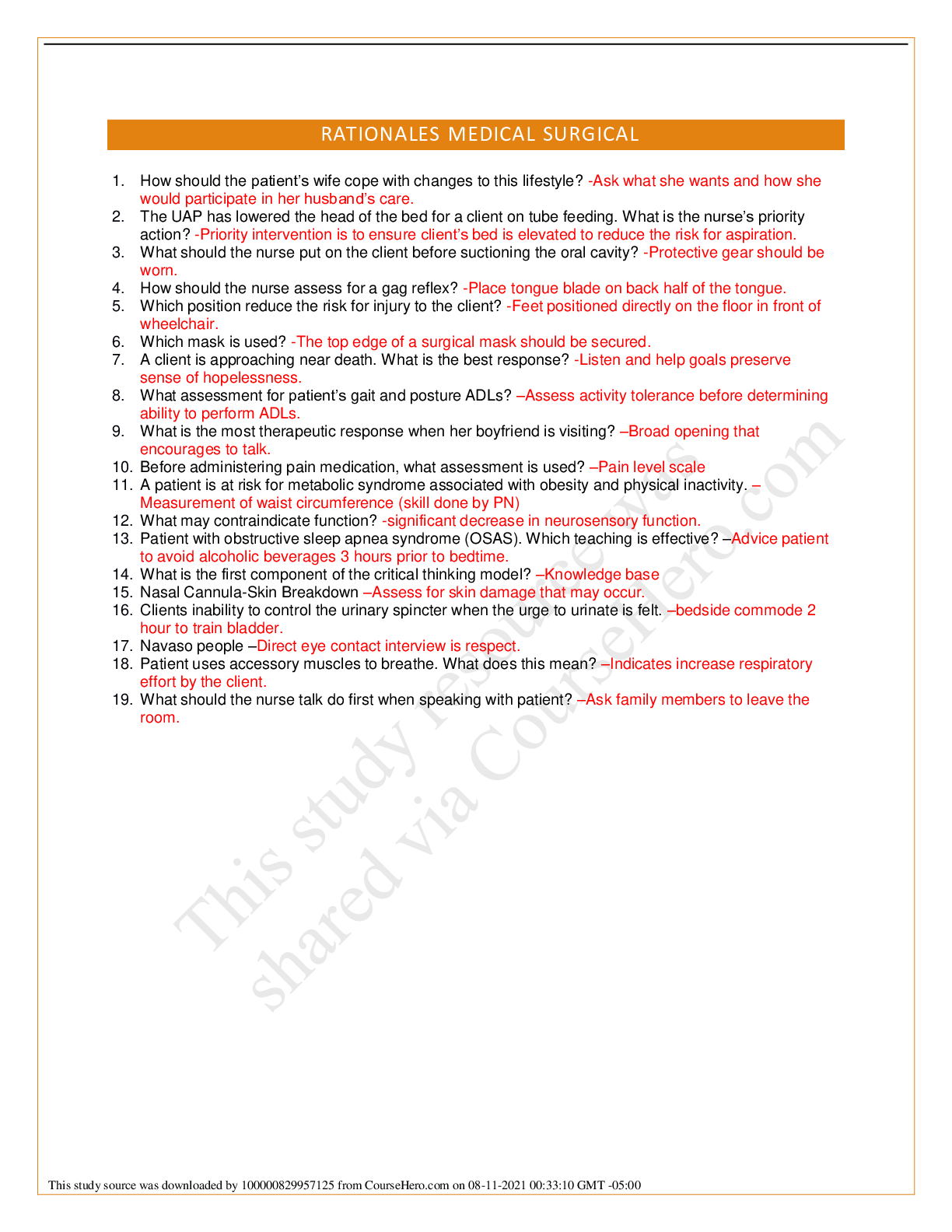
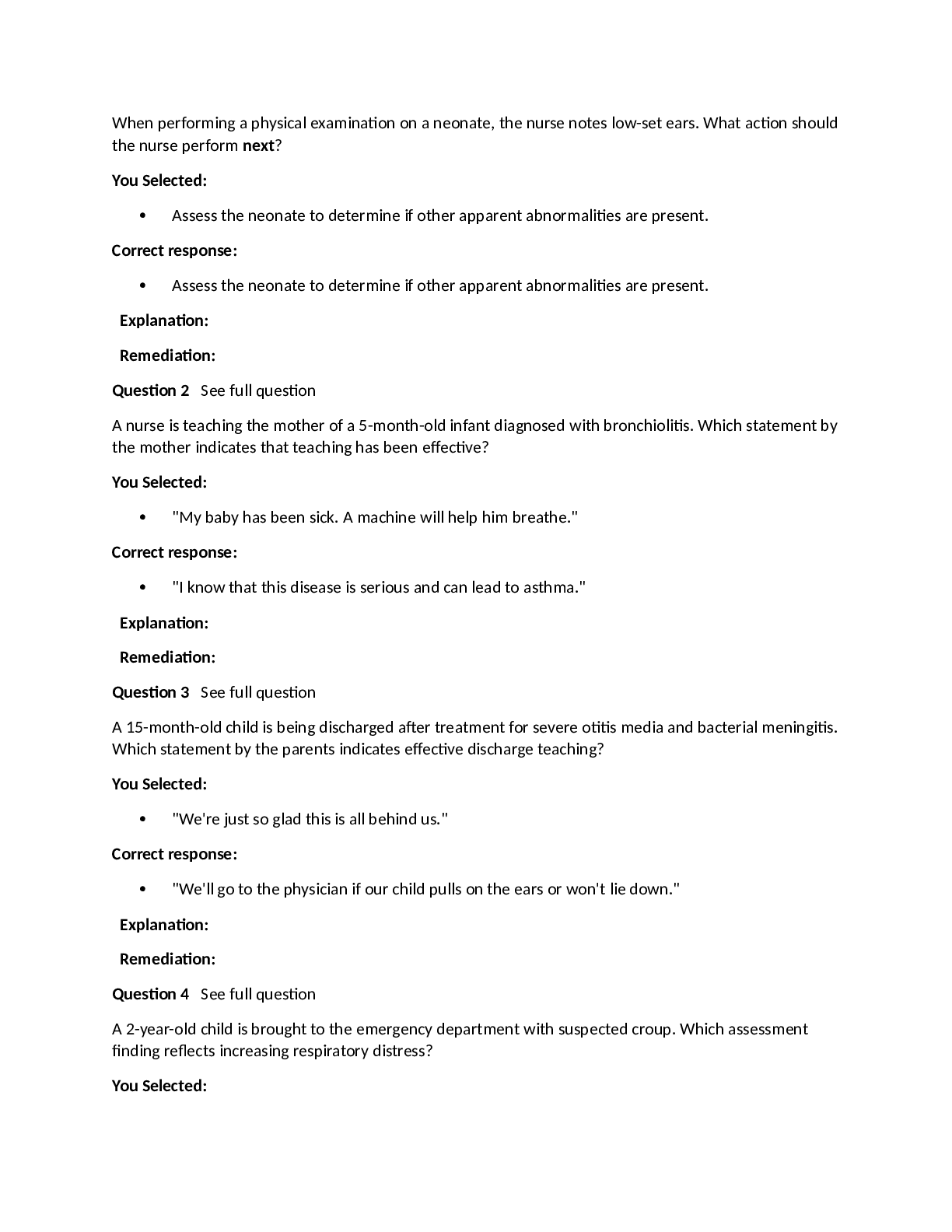
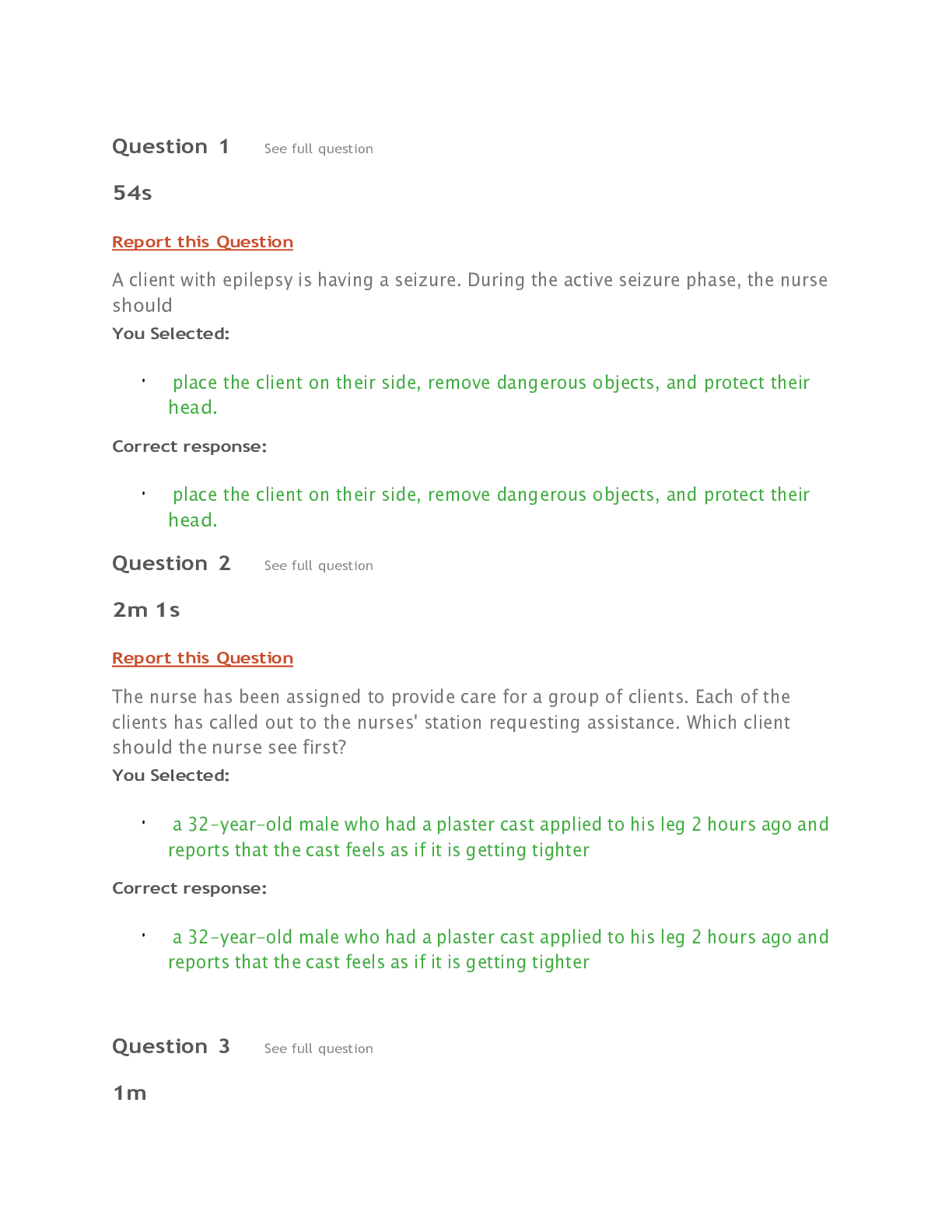
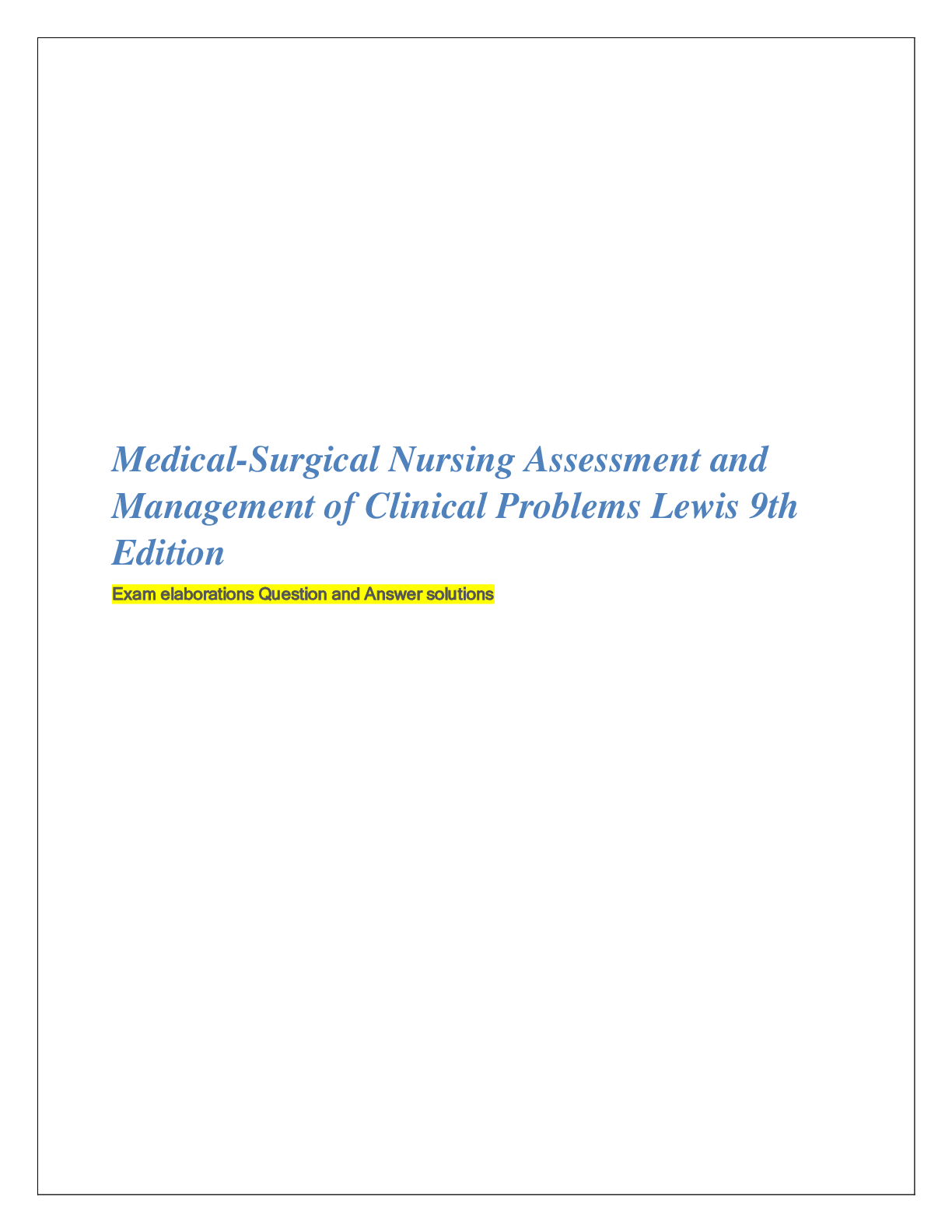

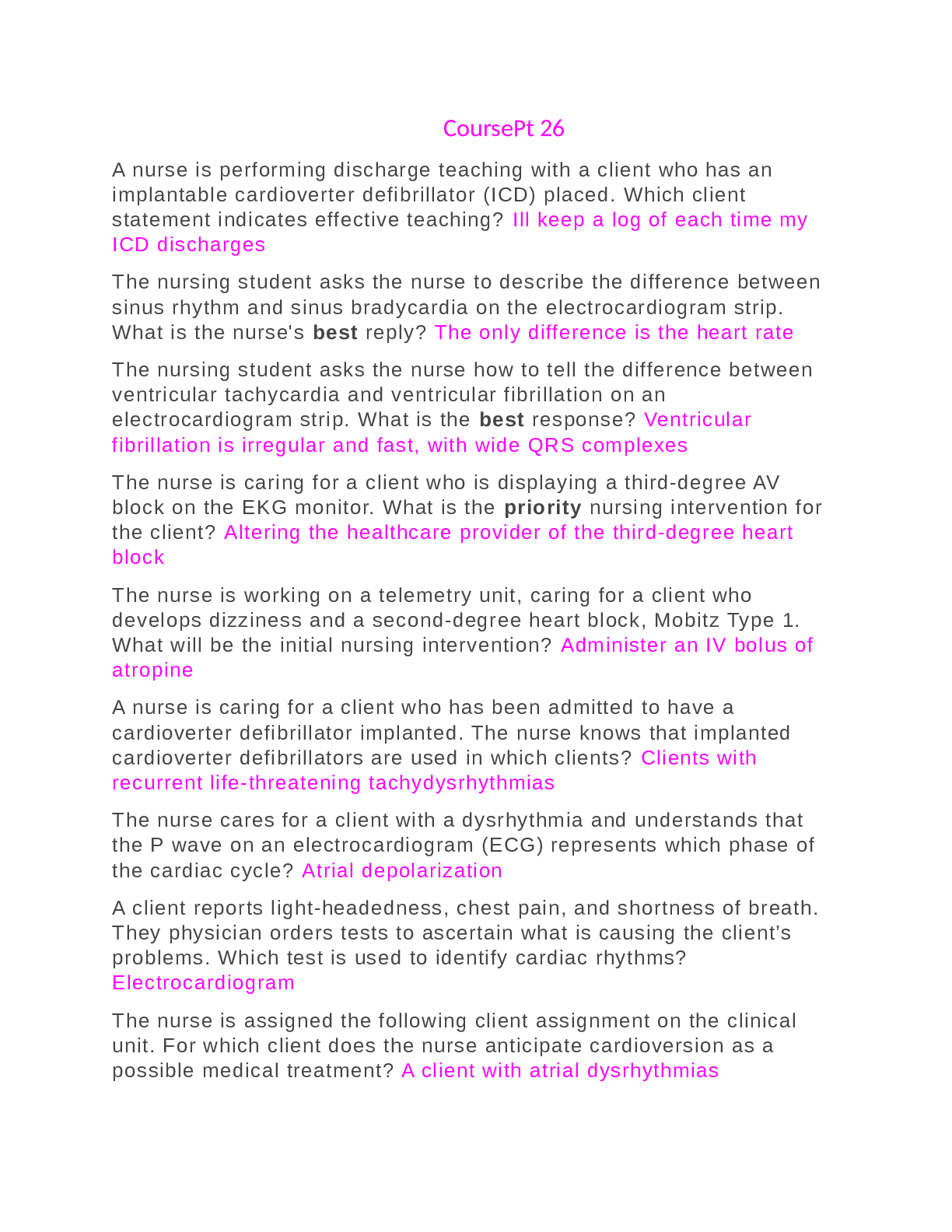
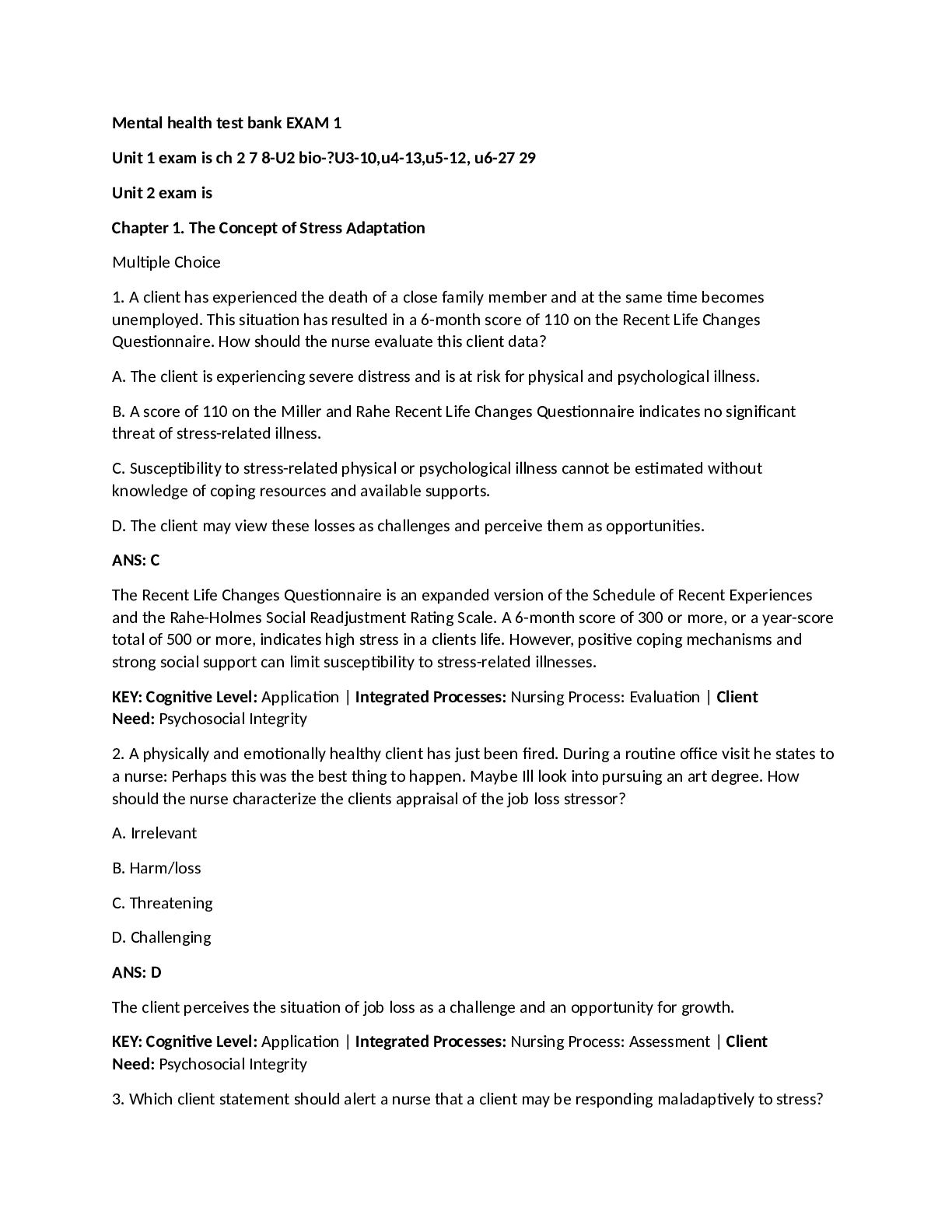
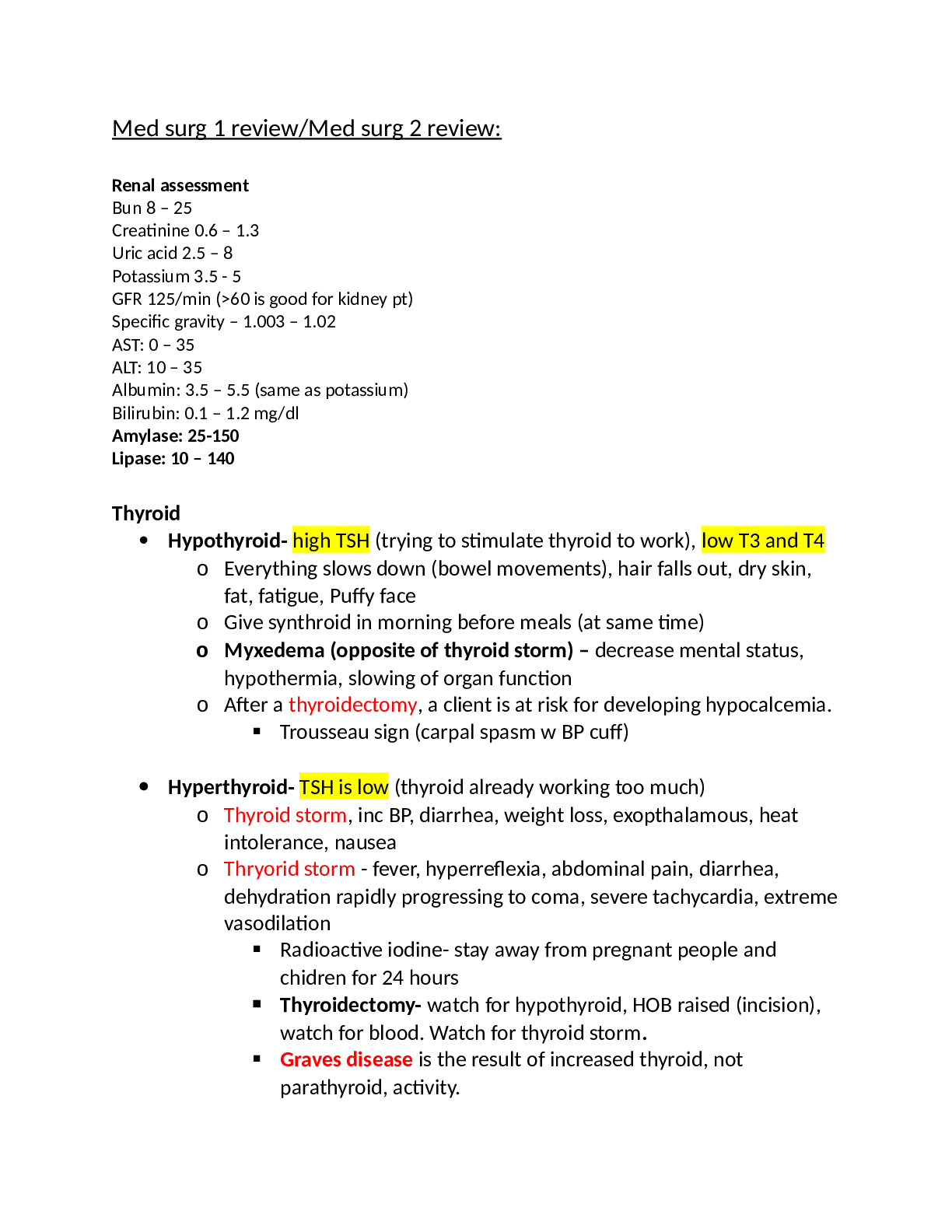

 (1).png)


